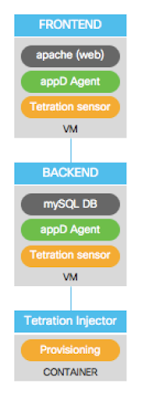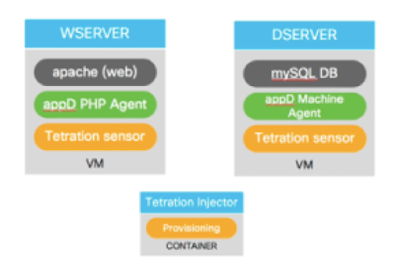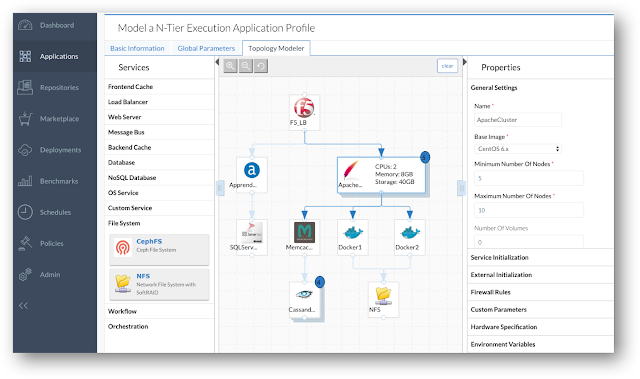Recently I presented a session at Codemotion Milan, with my colleague Stefano Gioia.
We demonstrated how the API exposed by the Cisco CloudCenter Suite can be easily integrated from within an Alexa skill.
Of course, this is not something you would do in the real life in a production environment 🙂
But it’s an easy and funny way to show how easy the integration is, and we found it attractive for our customers and partners.
Instead of Alexa you could use any client, like a custom script from the command line, a workflow engine, a web portal or a ITSM system like ServiceNow to achieve the same result.
Any program that can do a REST call can drive CCS (CloudCenter Suite) externally to orchestrate the lifecycle of a software deployment.
In case you use Alexa, you will code the REST client logic in the serverless implementation of the “skill” that is executed as a Lambda function. You can use different languages to create the skills: we chose node.js for the demo.
We decided to show some basic CCS features like deploying any kind of software in any cloud, or measuring the cost of all the services we are consuming in all our clouds (for running VM and containers, for consuming cloud services like load balancers or network bandwidth, for running serverless functions. etc.). Of course there is much more in the product, but we wanted to keep the demo light and funny.
 |
| The 3 modules of the Cisco CloudCenter Suite |
Everything you can do in the CloudCenter web portal can also be done through its REST API, and the CCS documentation shows examples you can easily reuse and adapt.
These are the API targets, for the different modules, that we used in the implementation of the skill:
Suite Admin API
/suite-idm/
E.g.: https://na.cloudcenter.cisco.com/suite-idm/api/v1/tenants
Workload Manager API
/cloudcenter-ccm-backend/api/v2/apps
E.g.: https://na.cloudcenter.cisco.com/cloudcenter-ccm-backend/api/v2/apps
Action Orchestrator API
/be-console/
E.g.: https://na.cloudcenter.cisco.com/be-console/api/v1/workflow
Cost Optimizer API
cloudcenter-shared-api
E.g.: https://na.cloudcenter.cisco.com/cloudcenter-shared-api/api/v1/costByProvider?cloudGroupId’
Next picture shows the high level process that allows a user to get something done by Alexa, just by speaking to a Echo device or to the Alexa mobile application.
The speech recognition system translates the user’s voice to text, then the “intent” of the user is matched to one of the functions available in the skill. Skills and their intent are executed based on patterns and keywords that the system is able to recognize in the natural language, thanks to machine learning algorithms.
Recognizing an intent triggers your custom code, that is generally a Lambda function (the Amazon developer console makes it easy to write the code and to host it in the Lambda service, providing also reusable examples). The outcome is rendered as audio or, depending on the device, also as a video.
In our specific demo, we put the client code for the Cisco CloudCenter API in the serverless implementation of the intent.
These are the commands that we can give Alexa:
Here you can see a sample of the capabilities of Alexa when it calls the Cisco CCS API:
These are the commands that we can give Alexa:
- give me the list of existing tenants
- list all configured target clouds
- deploy a database or a web server in a cloud
- show current cost of all cloud services
Here you can see a sample of the capabilities of Alexa when it calls the Cisco CCS API:
Building a new Alexa custom Skill: as the skill developer, you have to:
- Define the requests the skill can handle
- Define the name Alexa uses to identify your skill, called the invocation name
- Define the utterances and input variables, called slots
- Write the code to fulfill the request
- Test it from the developer console or from your Alexa device
The documentation at the Amazon Developer console contains excellent tutorials to build Alexa skills.
You can learn easily to create a Hello World skill, then you are ready to incorporate the client code to call the CloudCenter Suite API.
Stefano has published his examples in github here, feel free to test it yourself.
You can learn easily to create a Hello World skill, then you are ready to incorporate the client code to call the CloudCenter Suite API.
Stefano has published his examples in github here, feel free to test it yourself.
This demo demonstrates that it's easy to build a client to drive the API exposed by CCS.
And it helps positioning the CloudCenter Suite as a mediation layer in your architecture, to orchestrate the lifecycle management and to define a governance model including cloud cost control.
And it helps positioning the CloudCenter Suite as a mediation layer in your architecture, to orchestrate the lifecycle management and to define a governance model including cloud cost control.
































